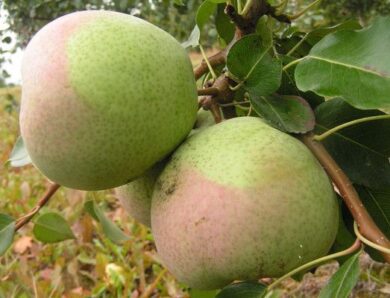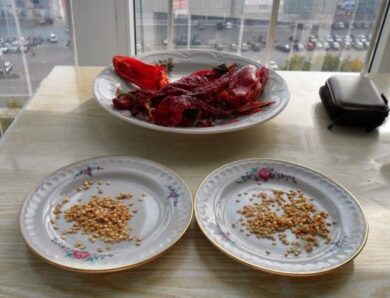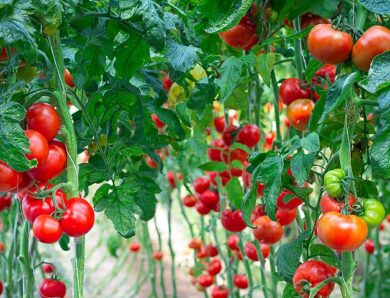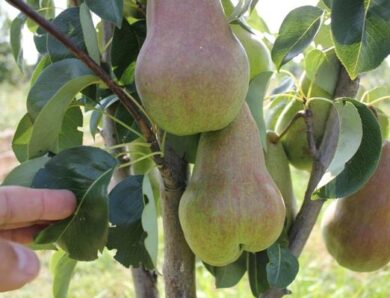Ussuri pear: description and characteristics of the variety
In the Far East, in Siberia and Northeast Asia grows Ussuri pear - the most frost-resistant pear of all known today. Due to its merits, it has participated in the creation of many popular varieties. This wild tree does not tire of surprising the variability of its fruits, depends on the place of growth.
History of appearance
The description of Ussuriyka was first made by the Russian botanist Karl Maksimovich in the middle of the last century.. He met an impressively beautiful wild tree with delicious fruit, which can grow and bear fruit, despite severe winter frosts. Ivan Michurin proved it, that on the basis of this pear it is possible to deduce new grades, which will combine the resistance of anthrax with the qualities of more southern fruits. He created the now famous varieties of October Beret, Takes winter, Fat runner. Michurin's followers continued his work: on the basis of the Ussuri pear were derived Far Eastern Theme, Fields, Olga, Lida, as well as Altai Zoya, The firstborn of the Altai.
Pear is successfully used as a rootstock for growing crops in cold climates. However, it grows well in more southern regions, moreover, the fruits of this game are tastier and larger without any vaccination. Of course, if it grows on fertile land and receives a lot of sunlight.
Variety description
The tree grows to 10-15 m in height, thick crown, wide, may be broadly pyramidal, rounded, expansive, well regulated by pruning. Shoots with thorns are yellowish-brown or brown with redness or grayness, they are not pubescent. The leaves are elongated with a characteristic ciliate-serrated edge, top - glossy green, bottom - matte and much lighter.
The tree looks very decorative: in spring the leaves are red, by summer they acquire traditional green, and in autumn they turn yellow spectacularly. But the most impressive is the pear during flowering - it is covered with large (to 4 cm in diameter) saucer-shaped flowers, collected in large inflorescences, and a very pleasant sweet aroma spreads around.
The fruits ripen in August and September. They are usually small - from 3 to 5 cm in diameter, slightly elongated. The color depends on the soil and climate - it is green, greenish-yellow, yellow with red barrel. Subcutaneous spots are clearly visible on them. The flesh is white or cream, sweet and sour, tart, with hard spots, which almost disappear after ripening.
The strangest thing about this pear is its extraordinary variability. If you buy two identical seedlings, plant them in different places, then in a few years the trees will look like representatives of different varieties, their fruits may differ in weight (will increase to 100 G), form, color, taste. This explains the fact, that the game is often planted in the country, and for many years use its fruits in compotes, kvass, jams. They are rarely eaten fresh.
Landing rules
Plant it in spring or autumn, the pit is prepared in advance, at least for 3 weeks, it is better to prepare it in the fall for spring planting. You need to choose a sunny place, but protected from the winds, with deep groundwater.
Ussuri pears are unpretentious, will take root on any soil, but if we are interested in the quality of the fruit (and it is often planted in cities as an ornamental), then you need to prepare a breathable fertile soil with pH acidity 6-6,5. Its roots are wide, crumpled, so it is better to dig a hole wider and deeper, especially if you have to change the structure of the soil and fill it with fertilizers.
At the bottom make a drainage layer, then pour a mixture of sod and leaf soil with humus, compost, wood ash, lime (if you want to reduce the acidity), mineral fertilizers. A strong peg is hammered into the center of the pit, then put the seedling, straighten the roots, carefully cover with earth completely, tied to a peg, abundantly watered. The earth, that settled after watering, get enough sleep, to root neck on 3 cm rose above ground level. Then mulch with grass, son, leaves.
Tree care
A young tree needs a lot of moisture, in a year it is watered once a month, if there is no rain. Moisture should be during flowering and ovary formation, and then it is desirable to carry out moisture-absorbing watering in the fall.
Fed depending on the condition of the soil. Nitrogen fertilizers are usually applied in the spring, in autumn - potassium-phosphorus, make organics through 3-4 years.
Stump circles should be kept clean, sometimes loosen, mulch, which retains moisture and protects against pests. Fallen leaves and fruits should not be left under the tree.
Despite the amazing frost resistance, the trunks of young trees are sure to cover for the winter, they are tied with burlap and spruce spruce. They are high up, mulch with a thick layer of hay or compost.
It is desirable to treat the tree in the spring with a solution of colloidal sulfur, to protect against gall mites. Carbophos or Nitrafen will save you from pear copper. Bordeaux liquid or copper sulfate will protect against rust.
Video "Feeding fruit trees"
In this video you will learn about it, how to properly fertilize fruit trees.




